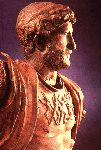| Background,
Sources, Copyrights |
|
 The
story is fairly well-known: The Roman emperor Hadrian (AD 76-138) fell in love
with the boy Antinous (approx. AD 110-130). He thereafter accompanied Hadrian
on his extended trips through the Empire. At age 20, Antinous drowned himself
in the Nile The sovereign mourned for his friend for the rest of his life. He
ordered the foundation of a city, Antinoopolis, at the place where Antinous
had died. At his old-age residence, the “Villa” in Tivoli, he surrounded
himself with statues and busts of Antinous. A star or constellation was named
after Antinous. Throughout the Roman Empire, cities that were indebted to Hadrian
gave their respective city-god the epithet Antinous and put up statues of this
idol. A cult of the god Antinous arose, and temples were built in his honor.
As a result, images of the young man are the most frequently found ancient statues
in the Mediterranean area. His cult achieved some significance, mainly in the
eastern part of the empire, and is attested through the end of the 5th century.
The
story is fairly well-known: The Roman emperor Hadrian (AD 76-138) fell in love
with the boy Antinous (approx. AD 110-130). He thereafter accompanied Hadrian
on his extended trips through the Empire. At age 20, Antinous drowned himself
in the Nile The sovereign mourned for his friend for the rest of his life. He
ordered the foundation of a city, Antinoopolis, at the place where Antinous
had died. At his old-age residence, the “Villa” in Tivoli, he surrounded
himself with statues and busts of Antinous. A star or constellation was named
after Antinous. Throughout the Roman Empire, cities that were indebted to Hadrian
gave their respective city-god the epithet Antinous and put up statues of this
idol. A cult of the god Antinous arose, and temples were built in his honor.
As a result, images of the young man are the most frequently found ancient statues
in the Mediterranean area. His cult achieved some significance, mainly in the
eastern part of the empire, and is attested through the end of the 5th century.
The goal of the following collection is Antinoos to show as many as possible
of the Antinous sculptures scattered in museums and private collections throughout
the world, and to make possible a comparison of the astonishing variations of
the ideal.
We assume in a good faith that these pictures are in the Public Domain. If
we have violated any proprietary feelings by the publication of any photo, we
ask you to inform us of that fact, and we will immediately remove that photo.
This page is a modest contribution to the study of Antinous, and serves no commercial
purpose.
The technical side is accepted the responsibility by J.
C. Grodos from Bruxelles to which everyone who has questions as regards
content on the Antinoos topic please would like to turn for. As the maker of
this Homepage, I am responsible for this
collection in the legal, moral and technical sense. The two other members
of our international team are J. Rohrbach from Madrid and Phoenix
from Dresden. we would also like to thank numerous other helpers, such as Barry
Stone from Brisbane and Othmar Rahm from Bonn.
Wolfgang Rüddenklau
(c) antinoos.info unless otherwise notes
 The
story is fairly well-known: The Roman emperor Hadrian (AD 76-138) fell in love
with the boy Antinous (approx. AD 110-130). He thereafter accompanied Hadrian
on his extended trips through the Empire. At age 20, Antinous drowned himself
in the Nile The sovereign mourned for his friend for the rest of his life. He
ordered the foundation of a city, Antinoopolis, at the place where Antinous
had died. At his old-age residence, the “Villa” in Tivoli, he surrounded
himself with statues and busts of Antinous. A star or constellation was named
after Antinous. Throughout the Roman Empire, cities that were indebted to Hadrian
gave their respective city-god the epithet Antinous and put up statues of this
idol. A cult of the god Antinous arose, and temples were built in his honor.
As a result, images of the young man are the most frequently found ancient statues
in the Mediterranean area. His cult achieved some significance, mainly in the
eastern part of the empire, and is attested through the end of the 5th century.
The
story is fairly well-known: The Roman emperor Hadrian (AD 76-138) fell in love
with the boy Antinous (approx. AD 110-130). He thereafter accompanied Hadrian
on his extended trips through the Empire. At age 20, Antinous drowned himself
in the Nile The sovereign mourned for his friend for the rest of his life. He
ordered the foundation of a city, Antinoopolis, at the place where Antinous
had died. At his old-age residence, the “Villa” in Tivoli, he surrounded
himself with statues and busts of Antinous. A star or constellation was named
after Antinous. Throughout the Roman Empire, cities that were indebted to Hadrian
gave their respective city-god the epithet Antinous and put up statues of this
idol. A cult of the god Antinous arose, and temples were built in his honor.
As a result, images of the young man are the most frequently found ancient statues
in the Mediterranean area. His cult achieved some significance, mainly in the
eastern part of the empire, and is attested through the end of the 5th century.